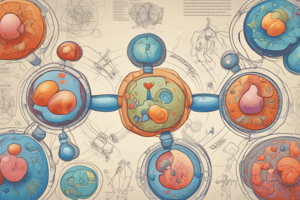Podcast
Questions and Answers
What percentage of human body weight is constituted by lipids?
What percentage of human body weight is constituted by lipids?
- 25-30%
- 15-20% (correct)
- 5-10%
- 35-40%
What is the main reason triacylglycerols are the body's fuel reserve?
What is the main reason triacylglycerols are the body's fuel reserve?
- They are highly concentrated form of energy (correct)
- They are non-essential for bodily functions
- They are found in small quantities in the body
- They are highly polar and hydrophilic in nature
How much energy does one gram of triacylglycerol yield?
How much energy does one gram of triacylglycerol yield?
- 9 Cal/g (correct)
- 2 Cal/g
- 10 Cal/g
- 4 Cal/g
What is the main difference between the storage of triacylglycerols and glycogen?
What is the main difference between the storage of triacylglycerols and glycogen?
How much of the body's energy needs can fats support during food deprivation?
How much of the body's energy needs can fats support during food deprivation?
What is the process called when triacylglycerol is completely degraded to glycerol and free fatty acids?
What is the process called when triacylglycerol is completely degraded to glycerol and free fatty acids?
What percentage of body lipids are triacylglycerols?
What percentage of body lipids are triacylglycerols?
Where does the activation of fatty acids occur during B-oxidation?
Where does the activation of fatty acids occur during B-oxidation?
What is the fuel reserve of the body stored in?
What is the fuel reserve of the body stored in?
What percentage of energy obtained from fat comes from the oxidation of fatty acids?
What percentage of energy obtained from fat comes from the oxidation of fatty acids?
What is the precursor for bile acids and steroid hormones?
What is the precursor for bile acids and steroid hormones?
During starvation, what happens to the triacylglycerol stored in adipose tissue?
During starvation, what happens to the triacylglycerol stored in adipose tissue?
What is the term for the process of lipolysis of TG and reesterification of FFA to TG?
What is the term for the process of lipolysis of TG and reesterification of FFA to TG?
What is the result of the oxidation of fatty acids by B-oxidation?
What is the result of the oxidation of fatty acids by B-oxidation?
What is the name of the enzyme that removes a fatty acid from triacylglycerol?
What is the name of the enzyme that removes a fatty acid from triacylglycerol?
What is the purpose of coenzyme A in B-oxidation?
What is the purpose of coenzyme A in B-oxidation?
Flashcards are hidden until you start studying
Study Notes
Lipids and Body Fuel Reserve
- Lipids make up approximately 15-20% of human body weight.
- Triacylglycerols (TG) comprise 85-90% of body lipids and are the most abundant lipids.
- TG is stored in adipose tissue and serves as the body's energy reserve.
Why Fat is the Fuel Reserve
- Triacylglycerols are a highly concentrated form of energy, yielding 9 Cal/g.
- Fatty acids in TG are in the reduced form, which allows for efficient energy storage.
- Triacylglycerols are non-polar and hydrophobic, allowing them to be stored in an anhydrous form without water.
- In contrast, glycogen and proteins are polar and require water for storage.
Triacylglycerols and Energy Storage
- One gram of fat stored in the body yields nearly six times as much energy as one gram of (hydrated) glycogen.
- In a healthy 70 kg adult, approximately 10-11 kg of fat is stored, which corresponds to a fuel reserve of 100,000 Cals.
Other Important Body Lipids
- Phospholipids, glycolipids, and cholesterol are major components of cell membranes.
- Cholesterol is a precursor for bile acids and steroid hormones.
Mobilization of Fat from Adipose Tissue
- Triacylglycerol lipase removes fatty acids from TG to form diacylglycerol and eventually glycerol and free fatty acids.
- This process is known as lipolysis.
Fate of Free Fatty Acids
- Free fatty acids are transported in the circulation bound to albumin and enter various tissues for energy production.
- About 95% of the energy obtained from fat comes from the oxidation of fatty acids.
Triacylglycerol/Fatty Acid Cycle
- During starvation, TG stored in adipose tissue is hydrolyzed to free fatty acids for oxidation and energy production.
- About 65% of these FFA are converted to TG and sent back to adipose tissue for deposition.
Fatty Acid Oxidation
- Fatty acids are mostly oxidized by B-oxidation, which involves the sequential removal of a two-carbon fragment, acetyl CoA.
- B-oxidation involves three stages: activation of fatty acids, transport of fatty acids into mitochondria, and oxidation proper in the mitochondrial matrix.
Coenzyme A and Fatty Acid Oxidation
- The coenzyme A used for activation is different from the one that finally combines with fatty acid in the mitochondria to form acyl CoA.
- The cell has two separate pools (cytosolic and mitochondrial) of coenzyme A.
Studying That Suits You
Use AI to generate personalized quizzes and flashcards to suit your learning preferences.




